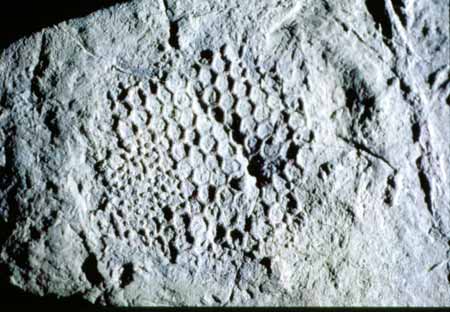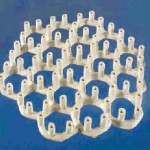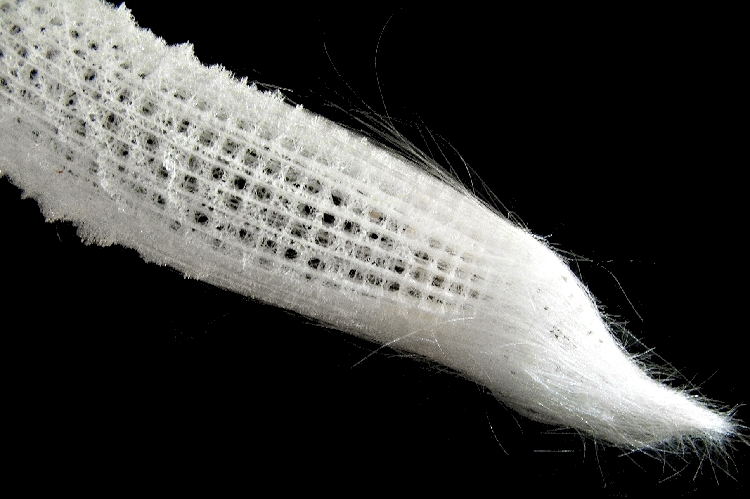
OK, now I'm obsessed with Paleodictyon. I mentioned this mysterious hexagonal entity briefly in my last post as an example of a trace fossil drawn by Leonardo da Vinci (see his sketch, left). But what is it - undersea mushroom garden, or the world's weirdest sponge?
 Paleodictyon is a fossil found in sedimentary rocks that once formed the deep seabed. It consists of a network of tunnels or tubes that would have sat a few millimetres underground, with vertical shafts leading up to surface. Palaeontologists traditionally interpret it as a burrow system, dug by an unknown maker. But Paleodictyon forms a perfectly regular hexagonal pattern, like a honeycomb (see fossil cast made by Yale palaeontologist Adolf Seilacher, left). What kind of animal could have dug such geometrically perfect tunnels?
Paleodictyon is a fossil found in sedimentary rocks that once formed the deep seabed. It consists of a network of tunnels or tubes that would have sat a few millimetres underground, with vertical shafts leading up to surface. Palaeontologists traditionally interpret it as a burrow system, dug by an unknown maker. But Paleodictyon forms a perfectly regular hexagonal pattern, like a honeycomb (see fossil cast made by Yale palaeontologist Adolf Seilacher, left). What kind of animal could have dug such geometrically perfect tunnels?
Now it turns out that this hexagonal structure may not be a burrow system after all, but the remains of a bizarre creature.
The story starts in 1976, when marine geologist Peter Rona of Rutgers University was using a giant sled carrying cameras and echo sounders to map the seabed of the Mid-Atlantic Ridge, around 3.5 kilometres down. In an area populated by black smoker hydrothermal vents, he found some strange patches of dots. The dots were holes, arranged in a "strikingly symmetric" hexagonal pattern. The patches were quite small, around 5 centimetres across, but there were thousands of them (see one of Rona's photos, below).
 The patterns were so regular, and so odd, that Rona apparently even wondered for a moment whether he had stumbled across the footprints of aliens from outer space. Then Seilacher got in touch and pointed out the similarity to Paleodictyon. Seilacher and other palaeontologists had assumed that whatever made Paleodictyon, it went extinct 50 million years ago. But Rona had found the modern-day equivalent.
The patterns were so regular, and so odd, that Rona apparently even wondered for a moment whether he had stumbled across the footprints of aliens from outer space. Then Seilacher got in touch and pointed out the similarity to Paleodictyon. Seilacher and other palaeontologists had assumed that whatever made Paleodictyon, it went extinct 50 million years ago. But Rona had found the modern-day equivalent.
Between 1990 and 2003, Rona made several trips down into the abyss, in the tiny manned sub Alvin, to scoop up cores of mud that contained the mysterious hexagonal structure. The project was featured in IMAX film, Volcanoes of the Deep Sea, in 2003, and Rona finally published his results in September 2009.
Rona's work was covered in this New York Times article, but I found it frustratingly light on detail regarding Paleodictyon itself so I thought I'd summarise the main findings here.
 When Rona studied Paleodictyon in the lab, he confirmed that the holes he had seen on the seabed are indeed the openings of vertical shafts, which lead to a honeycomb pattern of horizontal tunnels beneath the surface, just as seen in the fossil version (see model made by Hans Luginsland, left). The surface of the structure forms a raised shield-shaped dome in the seabed.
When Rona studied Paleodictyon in the lab, he confirmed that the holes he had seen on the seabed are indeed the openings of vertical shafts, which lead to a honeycomb pattern of horizontal tunnels beneath the surface, just as seen in the fossil version (see model made by Hans Luginsland, left). The surface of the structure forms a raised shield-shaped dome in the seabed.
Disappointingly Rona found no trace of any organism associated with the tunnel structure - no body parts, biological material, or DNA. Little sediment lands on this part of the seabed, so it may be that fresh-looking holes can persist on the seafloor for hundreds of years, even after the owner/inhabitant is long dead. But intriguingly, when Rona tested a model of the structure in a flume tanks, he found that the shield-shaped profile makes it self-ventilating - in other words, water currents are deflected through the structure in a way that keeps all of the tunnels aerated and supplied with organic particles.
The study has left Rona and Seilacher with completely different views on how the structures are formed. Seilacher sees Paleodictyon is an especially complex member of a group of fossils called graphoglyptids, which palaeontologists believe are all burrows. They come in a dizzying array of shapes and patterns, including hexagons, spirals and tree-like structures (there's a nice paper showing the range of graphoglyptids here). But they all divide a given surface into equal subunits, just as human-made drainage systems do.
Seilacher reckons that graphoglyptids are basically subsurface mushroom gardens, in which foods (bacteria or fungi) are cultivated by unknown animals, probably some kind of worm. So in theory it might be possible to send a robotic sub to sit for hours next to a fresh burrow and wait for the unknown tracemaker to visit its farm.
Rona, on the other hand, thinks the hexagonal pattern of tubes represents the remains of the organism itself. His tests found that levels of bacteria are no higher inside the tunnels than outside - evidence against the farming theory.
It is also hard to imagine how any creature could have dug such a regular pattern. You can get hexagonal patterns in nature from closely packing regular subunits, such as soap bubbles, eggs, corals or honeycomb cells. To weave or burrow them is much harder, yet defects such as elongated sides or missed vertices are very rare. A computer simulation carried out in 1993 showed that the burrower would need "outstanding navigational skills" including the ability to execute 60-degree turns with an accuracy of 2 degrees, and to measure the length of the hexagon sides with an accuracy of less than 1% (Journal of Geological Education 41, 159-163; 1993).
More recently, another study applied graph theory to the tunnel network. The researchers calculated the total tunnel length for networks of varying sizes, and used a theory originally developed by the mathematician Euler to work out the shortest path an animal would need to take to visit all the parts of its burrow. One fossilised example of Paleodictyon is a metre across. Its hexagons have a side-length of just 5 millimetres, with a tube diameter of less than 1 millimetre, so the animal that dug this burrow could not have been more than 5 mm long, or more than 1 mm across. The researchers calculate that the total tunnel length in this fossil is around 230 metres, and that the burrower would need to revisit previous parts of the path at least one third of the time. To maintain its burrow system, the organism would need to move an improbably long distance relative to its own size, perhaps 46,000 times its own length and 250,000 times its width.

Instead, Rona thinks that the hexagonal tube system is all that remains of a strangely adapted form of sponge. Once the animal dies, its body parts get eaten away, leaving just the imprint of its body shape.
Rona suggests the most likely candidate is a hexactinellid sponge. These are also known as glass sponges, and have an internal skeleton made up of a four- or six-pointed silica lattice (see dried skeleton of the deep sea glass sponge Euplectella, above left). Perhaps one of these sponges, flattened into a horizontal layer, might form a hexagonal network of tubes like Paleodictyon. The vertical shafts would then allow aerated water and food particles to circulate through the animal's body.
Both ideas seem quite mind-boggling but I reckon Rona's explanation is the most convincing. But if Paleodictyon is a sponge, not a burrow, what does this mean for other graphoglyptid "burrows"? Are they actually creatures too?